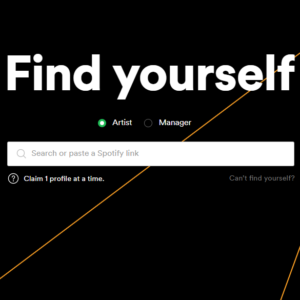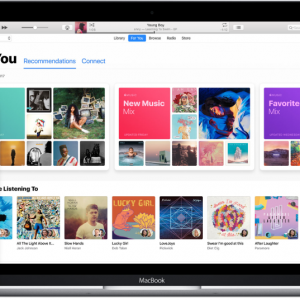Spotify is the largest streaming platform for music in the world - learn How to get on Spotify Playlists.
Millions of music lovers use Spotify every single day to listen to their favourite artists and discover new ones. Getting your music playlisted on streaming services like Spotify can be a game changer for independent artists to grow their fan base.
Types of Spotify Playlists
Before looking at the strategies and tactics involved in getting on a Spotify playlist, it’s a good idea to familiarise yourself with the different types of playlists in existence.
1. Personalized playlists
Personalized playlists are different for each listener, based on their unique taste. They’re created by algorithms that look at listener habits (what they play, save, like, share, skip, etc.) and the habits of people with similar tastes and use this information to produce these highly personalized playlists.
Two important algorithmic playlists include “Discover Weekly” and “Release Radar”.
The more followers you have, the more personalized playlists you get on.
-
Discover Weekly
Songs on Spotify’s ‘Discover Weekly’ playlist are included based on a user’s personal listening history and that of other Spotify users with the same taste in music.
-
Daily Mix
Songs on Spotify’s ‘Daily Mix’ playlist are included based on the genres preferred by listeners — i.e., if you listen to a load of jazz, Spotify is more likely to include jazz tracks on your Daily Mix playlist.
-
Release Radar
Spotify’s ‘Release Radar’ playlist is updated every Friday with up to two hours of new or relevant tracks from artists that you’ve shown interest in.
2. Spotify's New Music Friday Playlist
Spotify's New Music Friday is a playlist of new releases that updates every Friday. There are loads of different versions for different countries and regions.
It’s curated by Spotify's playlist editors - genre, lifestyle, and culture specialists with diverse backgrounds from all around the world.
3. Editorial playlists
These are playlists that are curated by Spotify’s Shows & Editorial team. This is a team of music experts and genres specialists from around the world, hired by Spotify to curate and manage Spotify’s own playlists. These playlists tend to have large followings and are typically the first playlists most people think of when discussing playlists on Spotify.
4. Listener playlists
Over the years, Spotify listeners have created millions of playlists. They’re a great way to understand your fans, get a sense of how your music resonates, and how your reach has grown.
They can influence other playlists, too. When fans save music to their playlists, it shows us what they like and what to recommend.
Also called user playlists or user-generated playlists, these are playlists that are created and maintained by Spotify users themselves.
Users can choose to make their playlists “secret” or “public”. While many Spotify users are simply regular users curating playlists for personal enjoyment, many businesses, companies, public personalities, and more also curate their own playlists, usually as a way to extend their branding.
5. Your own playlists
As you might expect, these are playlists created and curated by you.
How to get on each Spotify playlist
As you can see from the above, each Spotify playlist is quite different in nature, and getting a track on them involves very different tactics.
Making the most of your own Spotify playlists
The easiest Spotify playlist to get on, of course, is your own playlist. It’s really easy to create your own playlist and insert your own tracks on it (you’ll find some instructions on how to do this here).
However, your own playlists only really have value to you as an artist if other people start following them (and in large numbers).
Getting on other people’s Spotify Playlists
Getting on a popular playlist curated by somebody else can be massively beneficial to your music career. Equally, getting on lots of less popular playlists can also be really helpful too.
- Curated tastemaker playlists
There’s no way around it: getting your tracks on a popular curated ‘tastemaker’ playlist is hard — similar, in many ways, to getting playlisted on a radio station with a large listenership.
Accordingly, you will have to put in quite a lot of work to achieve results in this area. If you can identify the appropriate tastemakers, and you’re making the right stuff for their playlists, you’re in with a chance. But in order to achieve results, you will need to:
-
do extensive research into who the most relevant curators are
-
put a great pitch together
-
be prepared to chase curators up (respectfully) until you get a yes or no to your request for addition.
If all this sounds like a lot of work, it is — so, budget permitting, you might consider hiring an agency to help you with this task. Music PR companies like 1710Media are increasingly approaching Spotify playlist curators as part of their 360 degree music PR campaigns, and will already have a lot of the contacts and relationships you need for acceptance onto playlists in place.
(Feel free to contact us for more info on all that).
- Listener playlists
When artists think about getting onto other people’s playlists, they often think exclusively about the sort of curated tastemaker lists. But it’s really important to think in more ‘down to earth’ terms too, and encourage ordinary Spotify listeners to add your music to their lists too.
The easiest way to increase the number of people with your songs on playlists is to start with friends, family and colleagues — many will usually be more than happy to add your tracks to their playlists. Be systematic about this — make a list of every Spotify user you know (whom it is appropriate to ask!) and politely request an addition to a playlist.
(And, within reason, chase up until you get results!).
Then, ask any fans of your act to add your tracks to their playlists.
This can be done
-
via your band mailing list
-
via social media
-
on your music website, Bandcamp page etc.
-
via Facebook ads
-
from the stage at gigs.
Be explicit about things — explain to your followers that getting on playlists is important to your career and that adding you to them is a really positive way that they can support your music.
Algorithmic Spotify Playlists
As discussed above, when making a judgment as to whether or not to add you to an algorithmic playlist, Spotify looks at a lot of data associated with your music, including
-
its genre
-
how many people are playing it
-
what other music do they like
-
how many followers do you have
-
how many playlists you’re on (and what sort)
In other words, to get onto an algorithmic playlist, you’ve basically got to impress Spotify. And this involves taking the steps outlined above — reaching out to your friends, existing fanbase, and relevant genre curators to maximize the number of track saves, playlist additions, and follows.
TIP: if you’re releasing new music, you can use ‘pre-save campaigns’ to get a lot of people to save your tracks to a Spotify library in advance of its release. This maximizes the number of plays you’ll as soon as your track goes live, which can in turn send positive signals to Spotify playlisting algorithms. To create a pre-save campaign, you’ll need to use a tool like Feature FM or Linkfire.
How to get on Editorial Spotify Playlists
Getting on a Spotify editorial playlist is really difficult, but there are a couple of ways that you can end up on one.
Submitting your music to Spotify for consideration
The first method involves submitting your tracks directly to Spotify for playlist consideration. To do this,
-
register for the Spotify for Artists service
-
Upload the song you’d like considered to your usual digital distributor (1710Media is Spotify's preferred distributor) — but importantly, several weeks before the official release date (this gives the editorial team time to review it)
-
go to the Music > Upcoming section in Spotify for Artists where, a few days after your music has been sent to your digital distributor, you should see an option to submit your music to the playlist team.
How successful you will be with all this very much depends on luck, taste, and how much time the Spotify editorial team has to go through the 20,000 or so submitted tracks per day!
Raising your general profile
The other method of getting on a Spotify editorial playlist basically involves your act becoming more visible in the media, to the point where the Spotify editorial team notice your existence and reward you accordingly with a spot on a playlist. Reviews, features and interviews in the press can all help on this front.
Another thing that might draw the editorial team’s attention to you is a very noticeable jump in your Spotify play count (as a result of all the promo legwork you’ve put in after reading this article, for example!).
All tricky stuff to achieve, and then a matter of luck as to whether Spotify’s staff notices any of it, but the point is that your general approach to music promo, both online and offline, can end up attracting the attention of Spotify editorial team, with positive results.
Just as a radio DJ might pick up on you as a result of reading a Notjustok review of your record, so might a Spotify playlist editor.





